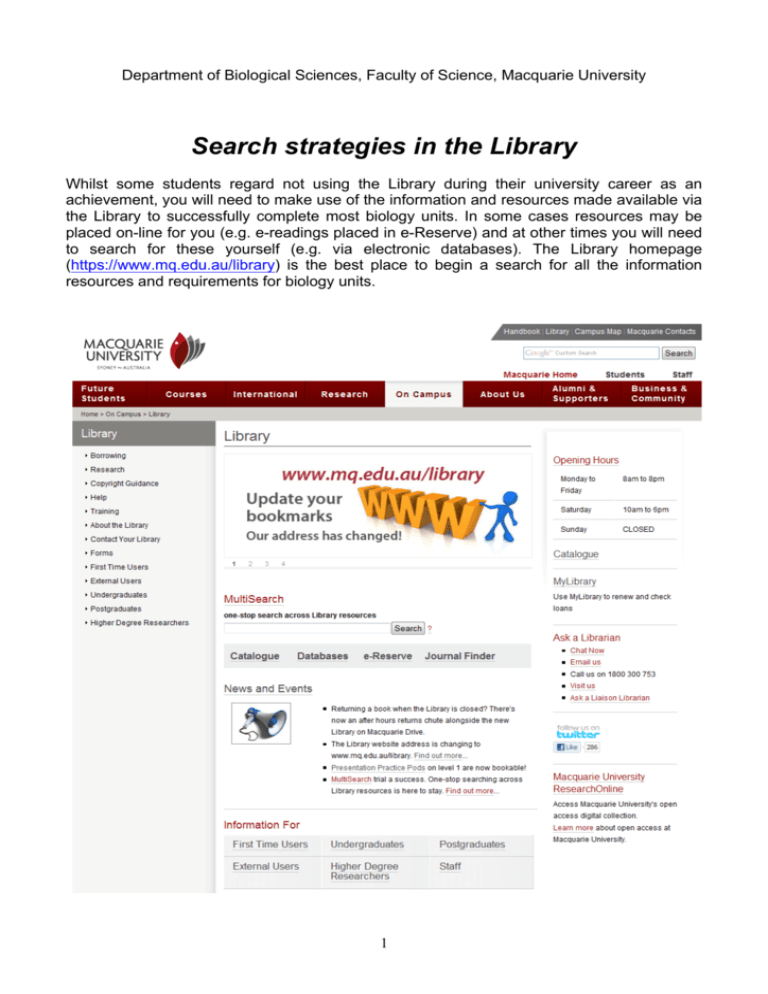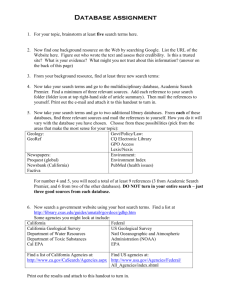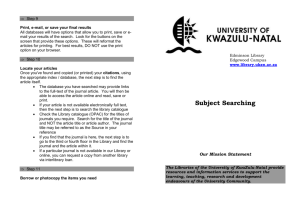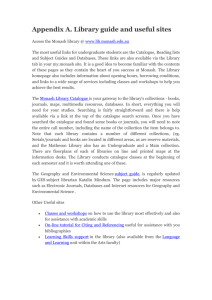Search strategies in the Library - Department of Biological Sciences
advertisement

Department of Biological Sciences, Faculty of Science, Macquarie University Search strategies in the Library Whilst some students regard not using the Library during their university career as an achievement, you will need to make use of the information and resources made available via the Library to successfully complete most biology units. In some cases resources may be placed on-line for you (e.g. e-readings placed in e-Reserve) and at other times you will need to search for these yourself (e.g. via electronic databases). The Library homepage (https://www.mq.edu.au/library) is the best place to begin a search for all the information resources and requirements for biology units. 1 Resources available in the Library can be searched for in several different ways. This guide provides a brief introduction to, and an outline of how to use, the most commonly used search methods to find information and resources in the Library: 1. CATALOGUE: Searching the Catalogue using Quick Search – Follow the Catalogue link to search for books and other resources (e.g. videos). 2. DATABASES: Using Databases to search for journal articles – A Database is an electronic collection of records including references to journal articles, reports, book chapters, conference papers etc. 3. E-RESERVE: Finding a journal article on e-Reserve – Select e-Reserve to link to a selection of unit reading materials made available online. 4. JOURNAL FINDER: Search for print and electronic journals by journal title – Select Journal Finder to search for journal titles in both print and electronic formats. 5. TRAINING: Online training notes and training notes – Select Training or Undergraduates to fin detailed information and notes on study and research skills, Library skills, support for assignments etc. 6. EVALUATING RESOURCES – Once relevant resources have been collected they need to be evaluated. This allows you to determine the best material available for a topic from the information you have collected. 2 1. CATALOGUE Searching the Catalogue using Quick Search 1. Click on Catalogue on the Library homepage (https://www.mq.edu.au/library) to go directly to the Quick Search for the Catalogue. 2. In the Search box enter keyword(s), or the first few words of a book title (e.g. Coral Reef Handbook) etc. Note: When searching for a book title in the Catalogue, don’t use articles (ie. a, an, the, le, la, et) at the beginning of the title (e.g. type: Coral Battleground instead of The Coral Battleground). If searching for a book by title, under Find Results in: select Title (first words). Click on the red Search button. 2. The search results for a book title using Quick Search show: • the Brief Record; or • a list of titles (if there is more than one edition, or titles with the same name) with call number(s) and loan availability. If more than one item is listed, check the author’s name and publication date to select the required title. Use the Sort By: function to order the list (e.g. Date most recent will sort the publication dates by latest date first). 3 3. Click on the title of the item to view its details. Once you have located the item required in the Library Catalogue you need to particularly note the following information. Collection in which the item is stored Call number Availability of item You can also use the Catalogue to locate journals held by the Library; alternatively you can use Journal Finder (see below). Note: The Library Catalogue (and online databases) uses the spelling palaeontology and paleontology, depending upon the country of origin of the document. e.g. Journal of Paleontology (an American journal) and Palaeontology (an English journal). 4 2. DATABASES Using Research Databases to search for journal articles 1. Click on the Databases link on the Library homepage (https://www.mq.edu.au/library). This will provide you with three entry points to the databases: • Search for Databases – Select a database by typing in a broad subject area (e.g. palaeontology), or type in the name of a known database (e.g. GeoRef). • Browse Databases by Name – An A-Z list of online and networked databases. • Browse Databases by Subject – Databases are listed by broad subject categories, similar to the teaching and research departments at Macquarie University. 2. Each method of accessing databases will create a list of databases that will give you: • A hypertext link to open that database. • Information on the type of record that the database provides. • Information about the database and its subject coverage. 5 2a. Using ScienceDirect to find journal articles ScienceDirect is a database that contains more than nine million full-text journal articles from more than 2500 science journals, as well as citations and abstracts of other journals. Subject coverage emphasises the life, medical, technical, and physical sciences, but there is also coverage of the arts, humanities, social sciences and psychology. 1. Click on the Databases link on the Library homepage (https://www.mq.edu.au/library). Select S and then choose ScienceDirect from the list of databases provided. 2a. Enter your keyword(s) in the Quick Search box, or click on Advanced Search for advanced search options. Click Go. A list of article references (citations) containing your search terms will be displayed. 2b. Alternatively, you can select Browse to look up a specific journal or article in a journal (e.g. Select P to find the journal Palaeogeography, Palaeoclimatology, Palaeoecology). 3. To view the full text of articles click on the article title or select the PDF link underneath each citation. If there is only an Abstract or Abstract + References link, then the full-text article is not available on this database. 6 2b. Using GeoRef to find journal articles The GeoRef database provides access to primarily citations and abstracts for the geoscience literature of the world. The database contains over 3 million references to geoscience journal articles, books, maps, conference papers, reports and theses. It covers the geology of North America from 1693 to the present and the geology of the rest of the world from 1933 to the present. Over 3500 journals in 40 languages are indexed. Links to some full-text articles in journals that the Library subscribes to are also provided. 1. On the Library homepage (https://www.mq.edu.au/library) click on the Databases link. 2. Select G and then choose GeoRef from the databases listed. This will take you to the Advanced Search screen in GeoRef where you can search using keyword(s). 3. To search multiple biological and geological databases (including GeoRef) at the same time select Change from the blue bar at the top of the screen and then Select all and Use selected databases. Note: You can search for the same word in GeoRef with different endings by dropping the last letter(s) of the word and adding *. e.g. If you type scleractinia*, then GeoRef will collect all references with Scleractinia, scleractinian and scleractinians in them. 7 4. Click Search. The number of citations containing your Search Term(s) will be displayed, as will a list of article references (or citations). 5. Click on each article title to view the abstract and detailed reference information. Some references also link to full-text versions of the articles. Click on Article Linker to see it the article is available via another database subscribed to by the Library. Note: Not all journals available electronically via the Library have an Article Linker link in GeoRef. You will need to check Journal Finder (and/or the Library Catalogue) to determine if the journal that you’re looking for is available electronically, or if the Library only holds a print copy. 8 3. E-RESERVE Finding a journal article on e-Reserve 1. On the Library homepage (https://www.mq.edu.au/library) click on e-Reserve. 2. Enter a unit code (e.g. BIOL379) into the Enter Unit Code: search box and click Go!. Alternatively, you can click on Browse Unit Codes and then click on the unit required. You can also search using keywords via the Enter Keyword(s) box to locate items. 3. Available materials, such as journal articles, past exam papers etc, will be listed. Click View Document to open each article, or Save Document to download and save each article. If there is a copyright pop-up screen click OK. 4. When asked for a Username and Password enter your MQID and password. Click OK. The full copy of the document will be displayed as a PDF document that can then be saved if required. 9 4. JOURNAL FINDER Search for print and electronic journals by journal title Journal Finder provides a list of journals held by the Library in both print and electronic formats. 1. On the Library homepage (https://www.mq.edu.au/library) click on Journal Finder. 2. Enter the name of a journal (e.g. Lethaia) into the Enter journal title keywords search box. Like the Catalogue, you don’t have to use the full title. For example, for the journal Palaeogeography, Palaeoclimatology, Palaeoecology, you only need to enter Palaeogeography into the search box. Click Find Journals! 3. A list of journal titles will be displayed containing your Search Term(s). In the example above, the journal Lethaia is available in both electronic format (from 1968 to present) and in print (from Vol. 1, 1968 to Vol. 37, 2004) at the call number QE701.L4 in the Automated Retrieval Collection. If the date for a journal article is only available within the time period for a print copy, either locate the journal at the call number on the shelves, or place a request to access the journal from the Automated Retrieval Collection. 4. Clicking on Electronic version will take you to the database on which that journal's contents are available. Note that some databases will link straight to the required journal and display the available volumes. Other databases will display a search box. 10 5. TRAINING Online training and training notes The Library offers a number of training courses and notes in a number of different areas such as study and research, Library skills, support for assignments etc that are aimed at assisting students in meeting their course work and research needs. 1. From the Library homepage (https://www.mq.edu.au/library) select either Training or Undergraduates on the left side of the screen. 2. A list of resources will be displayed. Click on the various links available to access the required training resources/materials. 11 6. EVALUATING RESOURCES Once relevant resources have been located they need to be evaluated. This evaluation allows you to determine the best material available for a topic from the resources you have located. 6a. Evaluating the material’s validity Authority — Check the authority of the material. Who is the author and who is the publisher? Are the author’s qualifications for writing the article or book identified? Is the author credible? Is the journal peer reviewed? Peer reviewed journals (e.g. Nature) have more academic credibility than non-peered reviewed sources and general publications (e.g. New Scientist). Accuracy — Check that the material is accurate. Are the sources for any factual information listed so they can be verified? Do charts and/or graphs containing statistical data have clear labels and up to date information? Are the statements or arguments made supported by facts? Objectivity — Check that the material is written objectively. Is the information provided as a public service? Does it come from an academic institution? Does the author or the publisher have a vested interest in the material? For example, Greenpeace would publish material with a different bias than a company that mined uranium. Currency — Check that the material is current. When was it written? Is it the most up to date material on the topic? Is there a newer edition? Has the material been revised? Coverage — Check what the material covers. Are all of the arguments on the topic, or is only one perspective presented? Are all areas of the topic relevant to your needs presented? Note: Always remember to get all the information needed to correctly cite the material you are using. This will save time and anxiety when creating your reference list. 6b. Evaluating the material’s relevance 1. Is the material at an appropriate level for the topic (not technical enough/too technical)? Does it help to answer the question or clarify the topic? 2. Do you understand what the material is saying? What is the article, book or website assuming and arguing? 3. Does it support or refute the argument you want to take when dealing with the topic? 4. What time frame is available for the research? 5. How much material do you need? A PhD student will need a much wider range of research resources than a first year undergraduate student doing an assignment. 12






